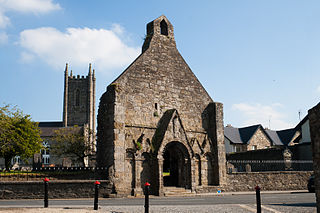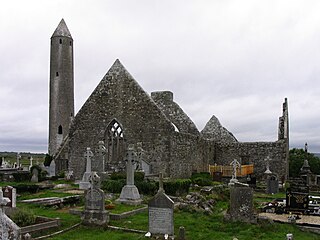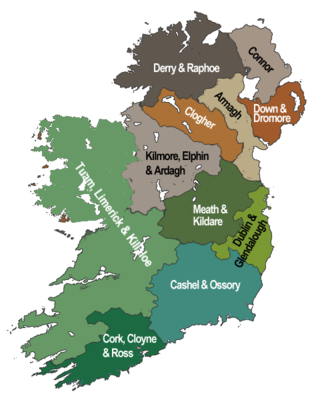Related Research Articles
The Archbishop of Cashel was an archiepiscopal title which took its name after the town of Cashel, County Tipperary in Ireland. Following the Reformation, there had been parallel apostolic successions to the title: one in the Church of Ireland and the other in the Roman Catholic Church. The archbishop of each denomination also held the title of Bishop of Emly. The Church of Ireland title was downgraded to a bishopric in 1838, and in the Roman Catholic Church, it was superseded by the role of Archbishop of Cashel and Emly when the two dioceses were united in 2015.
The Bishop of Killaloe is an episcopal title which takes its name after the town of Killaloe in County Clare, Ireland. In the Roman Catholic Church it remains a separate title, but in the Church of Ireland it has been united with other bishoprics.
The Bishop of Limerick, Killaloe and Ardfert or the Bishop of Limerick and Killaloe is the Church of Ireland Ordinary of the united Diocese of Limerick and Killaloe in the Province of Dublin. As of January 2022, the position was vacant, but due to be taken up by Michael Burrows.

The Diocese of Killaloe is a Roman Catholic diocese in mid-western Ireland, one of six suffragan dioceses in the ecclesiastical province of Cashel and Emly.

The Diocese of Tuam, Killala and Achonry is a former diocese in the Church of Ireland located in Connacht; the western province of Ireland. It was in the ecclesiastical province of Armagh. Its geographical remit included County Mayo and part of counties Galway and Sligo. In 2022, the diocese was amalgamated into the Diocese of Tuam, Limerick and Killaloe.

The Bishop of Limerick is an episcopal title which takes its name after the city of Limerick in the Province of Munster, Ireland. In the Roman Catholic Church it still continues as a separate title, but in the Church of Ireland it has been united with other bishoprics.
The Bishop of Kilfenora was a separate episcopal title which took its name after the village of Kilfenora in County Clare in the Republic of Ireland. In both the Church of Ireland and the Roman Catholic Church, the title is now united with other bishoprics.

The Bishop of Roscrea was an episcopal title which took its name after the town of Roscrea in County Tipperary, Ireland.
The Bishop of Limerick, Ardfert and Aghadoe was the Ordinary of the Church of Ireland diocese of Limerick, Ardfert and Aghadoe, which was in the Province of Cashel until 1833, then afterwards in the Province of Dublin.
The Bishop of Cashel and Waterford was the Ordinary of the Church of Ireland diocese of Cashel and Waterford; comprising all of County Waterford, the southern part of County Tipperary and a small part of County Limerick, Ireland.
The Bishop of Emly was a separate episcopal title which took its name after the village of Emly in County Tipperary, Republic of Ireland. In both the Church of Ireland and the Roman Catholic Church, it has been united with other sees.
The Bishop of Killaloe and Clonfert was the Ordinary of the Church of Ireland diocese of Killaloe and Clonfert; comprising all of County Clare and part of counties of Tipperary, Galway and Roscommon, Republic of Ireland.

The Bishop of Kilmacduagh was an episcopal title which took its name after the village of Kilmacduagh in County Galway, Ireland. In both the Church of Ireland and the Roman Catholic Church, the title is now united with other bishoprics.
Edwin Owen was an Anglican bishop in the Church of Ireland.
Christopher Butson was a Church of Ireland bishop in the first half of the 19th century.

The Dean of Cashel is the head of the Chapter of the Cathedral Church of St John the Baptist and St Patrick's Rock, Cashel, one of the Church of Ireland cathedrals of the united Diocese of Cashel, Ferns and Ossory.
John Roan,D.D. was a Church of Ireland Bishop of Killaloe.

The Archdeacon of Killaloe was a senior ecclesiastical officer within the Diocese of Killaloe until 1752; and then within the Diocese of Killaloe and Kilfenora until 1832 when it became the Diocese of Killaloe and Clonfert. As such he was responsible for the disciplinary supervision of the clergy within the diocese.
Denis Kelly, Doctor of Divinity was an Irish Roman Catholic Bishop.

The Diocese of Tuam, Limerick and Killaloe is a diocese of the Church of Ireland that is located in the west of Ireland. The diocese was formed by a merger of the former Diocese of Tuam, Killala and Achonry and the former Diocese of Limerick and Killaloe in 2022, after the retirement of the separate dioceses' bishops and the appointment of Michael Burrows as bishop of the united diocese. It is in the ecclesiastical province of Dublin. It is one of the eleven Church of Ireland dioceses that cover the whole of Ireland. The largest diocese by area in the Church of Ireland, it covers all of counties Clare, Galway, Kerry, Limerick and Mayo, plus parts of counties Cork, Sligo, Roscommon, Offaly, Laois and Tipperary.
References
- ↑ "A New History of Ireland" T. W. Moody, F. X. Martin, F.J. Byrne and Cosgrove, A: Oxford, OUP, 1976 ISBN 0-19-821745-5
- ↑ "Diocese of Kerry". Catholic Hierarchy. Retrieved 18 May 2009.
- ↑ Diocese of Killaloe
- ↑ Fryde, E. B.; Greenway, D. E.; Porter, S.; Roy, I. (1986). Handbook of British Chronology (Third ed.). Cambridge: Cambridge University Press. pp. 332–334. ISBN 0-521-56350-X.
